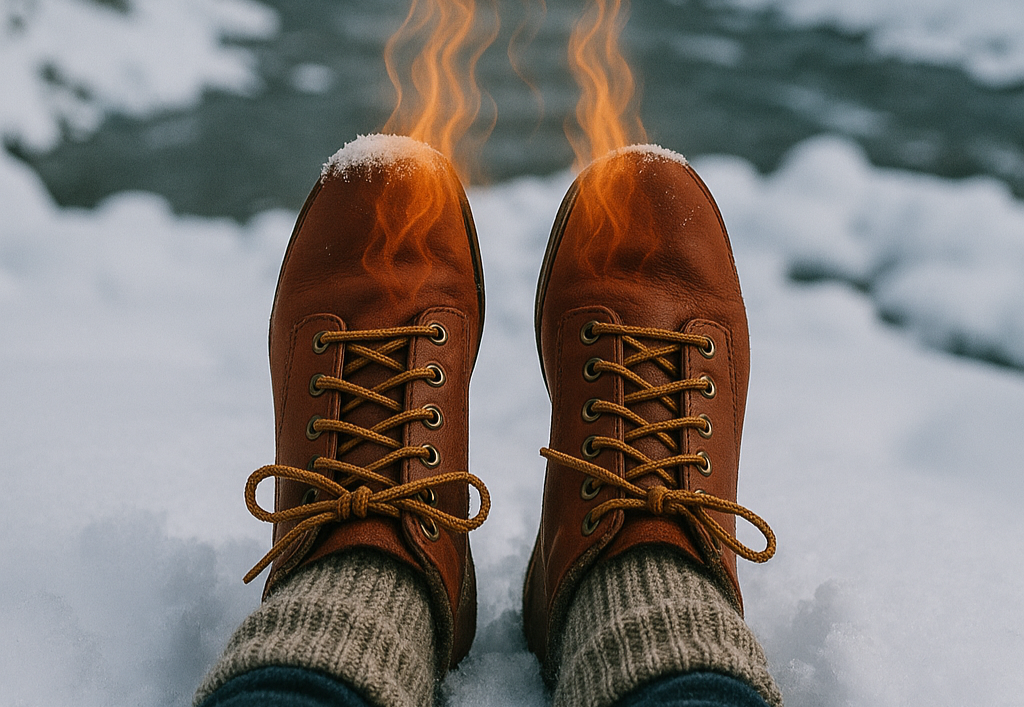The silent battle of winter isn't always against the biting wind or the slick ice. More often than not, it’s a more personal, localized skirmish waged right inside your boots. It’s the creeping chill that starts in your toes and slowly numbs its way up your foot, turning a beautiful day of skiing, a productive day of work, or a peaceful hike into a miserable endurance test.
This blog is a deep dive into the world of cold feet, not just the "why" but the "how-to." We’ll explore the science of how your body reacts to the cold, demystify the vast landscape of thermal insoles and heated foot inserts, and give you actionable advice on how to keep your feet warm and happy all season long. Whether you're a seasoned skier, a dedicated winter hiker, or someone who just can’t seem to escape the chill, you’re about to become an expert in foot warmth.
The Science of Cold Feet: Why Your Toes Get the Short End of the Stick
Before we talk about solutions, let's understand the problem. When your body is exposed to cold temperatures, its primary goal is to protect its vital organs: the heart, lungs, and brain. To do this, it begins a process called vasoconstriction, where blood vessels in your extremities (like your hands and feet) narrow. This diverts warm blood to your core, keeping your critical organs functioning. It's a brilliant survival mechanism, but it leaves your toes vulnerable and cold.
This is a particular challenge for skiers and snowboarders. You're standing in a cold, rigid ski boot, often at a high altitude where the air is thinner. This combination can dramatically accelerate the process, leaving you with numb, painful toes long before you're ready to call it a day. This is why search terms like "how to keep feet warm when skiing" are so popular—it's a problem a lot of people face, and the solution isn't always as simple as wearing thicker socks. In fact, thicker socks can sometimes make the problem worse by compressing your feet and restricting blood flow, which is exactly what your body is already trying to do.
The Heated Insole Revolution: A New Era of Warmth
For years, the options for cold feet were limited to thick socks, toe warmers, and the occasional desperate coffee break by a fireplace. But the market for thermal shoe inserts has exploded, offering a range of innovative solutions that provide sustained, targeted warmth.
Here's the solution you need to know about:
These are typically disposable, battery-free insoles that use a blend of materials (often iron filings) that react with oxygen to create a safe, consistent heat. They are a game-changer for people who need warmth for a long, continuous period without the hassle of charging.
The beauty of these disposable insoles is their simplicity: just open the package, slide them into your shoes, and go. They provide a reliable, long-lasting warmth that lasts for many hours, making them perfect for a full day on the slopes or a shift in a cold outdoor environment.
Learn more about the revolutionary technology behind Elos here.
Beyond the Insole: Other Tips for Keeping Your Feet Warm
While a quality pair of heated foot inserts can make a world of difference, they aren't the only piece of the puzzle. A holistic approach to foot warmth will give you the best results.
Choose the Right Socks: The sock choice is just as important as your footwear. Avoid cotton at all costs—it absorbs sweat and holds moisture against your skin, making your feet colder. Instead, opt for a wool blend or a synthetic material designed to wick moisture away from your skin.
Don't Overtighten Your Boots: This is especially true for skiers and snowboarders. Overtightening your boots can restrict blood flow, which, as we've discussed, is the primary reason your feet get cold. Make sure your boots are snug and supportive but not so tight that they cut off circulation.
Keep Your Core Warm: Remember that your body prioritizes your core temperature. By keeping your torso and head warm with the right layers, you're sending a signal to your body that it’s safe to send more blood to your extremities.
Stay Hydrated and Fuel Your Body: Your body generates heat through metabolism. Staying hydrated and eating a balanced meal will give your body the fuel it needs to stay warm.
Wiggle Your Toes: When you're standing still, try wiggling your toes. This simple movement can help improve circulation and bring warmth back to your feet.
Pre-heat Your Boots: If you're a skier, put your boots on inside where it's warm and walk around in them before you head outside. This will give your feet a warm starting point and make it much easier to stay warm on the mountain.
Finding the Right Solution for You
The market is full of options, from foot heater insoles to insulated shoe insoles and everything in between. Your choice depends on your specific needs.
For the All-Day Winter Enthusiast: If you're going to be out on the slopes from first chair to last, or working outdoors all day, a long-lasting, reliable solution like a chemical-activated insole is an excellent choice. You don't have to worry about a battery running out, and they provide consistent, dependable warmth.
For the Casual Cold-Weather Goer: If you're just looking for a little extra warmth for a chilly commute or a walk in the park, a passive thermal insole might be all you need. They're a cost-effective and simple way to keep your feet comfortable.
For the Tech-Savvy User: If you love customization and want to control the exact temperature of your feet, a rechargeable heated insole is a perfect fit. The ability to adjust the heat on the fly is a major advantage for people whose activity levels change throughout the day.
Don't let cold feet dictate your winter activities. By understanding the science and choosing the right gear, you can take control of your comfort and enjoy everything the season has to offer. So, this winter, when you hear that familiar chill, you'll be ready to meet the cold with Elos Heating Insoles.


